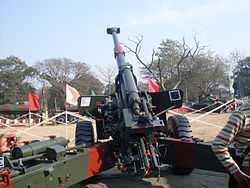DRDO 155 mm artillery gun
| 155 mm artillery gun | |
|---|---|
 | |
| Type | Towed howitzer |
| Place of origin | India |
| Service history | |
| Used by | Indian Army |
| Production history | |
| Designer | ARDE |
| Designed | 2010-2013 |
| Manufacturer | OFB, private industries |
| Produced | Expected from 2013 onwards |
| Specifications | |
| Length | 52 Caliber 8060 mm |
| Crew | 6-8 |
|
| |
| Caliber | 155 mm |
| Breech | Screw type |
| Recoil | Electro-rheological/Magneto-rheological |
| Elevation | -3 to 70 degree |
| Traverse | +/-25 |
| Rate of fire | Burst:3 rounds in 15sec Intense: 15 rounds in 3 minutes Sustained: 60 rounds in 60 min |
| Maximum firing range | 38[1] Km[2] |
| Sights | Thermal sight. Gunners display |
The DRDO 155 mm artillery gun project was started by India since there are delays associated with the procurement of artillery guns due to issues of corruption and irregularities. Many of the companies that bid for the contract are either blacklisted for utilizing unfair means to gain the contract leading to single vendor issues and guns not meeting the requirement of the Indian Army. The artillery guns were not procured after the Bofors scandal. Hence it was planned to replace the older guns with a modern indigenously developed 155mm artillery gun.[3] DRDO along with private companies including L&T, Bharat forge are developing a 155 mm artillery gun, that is to be handed over to the Indian Army for trials in 2013.[4]
In a presentation made to defence minister A K Antony, the Army informed DRDO that it would place orders for over 140 howitzers after the artillery guns are field tested. DRDO’s Pune-based Armament Research and Development Establishment (ARDE) is the lead research agency to develop the 155mm 52 calibre indigenous howitzer for the Army.[5]
Recently, DRDO held an interaction with various Indian private sector industries to explore the feasibility of involvement of private firms in the development of Advanced Towed Artillery Gun System (ATAGS). Objective of the interaction was to explore and encourage participation of Indian industries in the ATAGS project and generate a base for its design, development, manufacturing and integration.Some of the major private and public sector firms which participated in the interaction were Tata Power SED, L&T, Bharat Forge, Mahindra Defence System, BHEL and BEL. Improved firepower at longer ranges, higher accuracy and enhanced survivability are some of the primary requirements for this gun system. Efforts are being made to develop new technologies for weapon platforms, automation and control systems, recoil management, materials to achieve improved weapon performance. The army has ordered 116 guns from the government's ordnance factory and could increase the order to 416 pieces of artillery. If the trials go off smoothly, the factory plans to double its manufacturing capacity from the current 18 guns a year.[6]
References
- ↑ http://www.newindianexpress.com/nation/%E2%80%98Dhanush%E2%80%99-Ready-after-Final-Trials-in-Pokhran/2014/06/21/article2291439.ece
- ↑ http://www.business-standard.com/article/economy-policy/indian-artillery-guns-make-a-splash-at-defexpo-114020800949_1.html Indian artillery guns make a splash at DefExpo
- ↑ 155-mm gun contract: DRDO enters the fray
- ↑ DRDO may field Indigenous 155-mm gun for the Indian Army by end of 2013
- ↑ Army assures DRDO on howitzers
- ↑ DRDO Holds Parleys with Tata, L&T, BEL for Howitzers